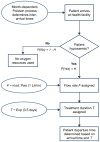Estimating oxygen needs for childhood pneumonia in developing country health systems: a new model for expecting the unexpected
- PMID: 24587089
- PMCID: PMC3930752
- DOI: 10.1371/journal.pone.0089872
Estimating oxygen needs for childhood pneumonia in developing country health systems: a new model for expecting the unexpected
Abstract
Background: Planning for the reliable and cost-effective supply of a health service commodity such as medical oxygen requires an understanding of the dynamic need or 'demand' for the commodity over time. In developing country health systems, however, collecting longitudinal clinical data for forecasting purposes is very difficult. Furthermore, approaches to estimating demand for supplies based on annual averages can underestimate demand some of the time by missing temporal variability.
Methods: A discrete event simulation model was developed to estimate variable demand for a health service commodity using the important example of medical oxygen for childhood pneumonia. The model is based on five key factors affecting oxygen demand: annual pneumonia admission rate, hypoxaemia prevalence, degree of seasonality, treatment duration, and oxygen flow rate. These parameters were varied over a wide range of values to generate simulation results for different settings. Total oxygen volume, peak patient load, and hours spent above average-based demand estimates were computed for both low and high seasons.
Findings: Oxygen demand estimates based on annual average values of demand factors can often severely underestimate actual demand. For scenarios with high hypoxaemia prevalence and degree of seasonality, demand can exceed average levels up to 68% of the time. Even for typical scenarios, demand may exceed three times the average level for several hours per day. Peak patient load is sensitive to hypoxaemia prevalence, whereas time spent at such peak loads is strongly influenced by degree of seasonality.
Conclusion: A theoretical study is presented whereby a simulation approach to estimating oxygen demand is used to better capture temporal variability compared to standard average-based approaches. This approach provides better grounds for health service planning, including decision-making around technologies for oxygen delivery. Beyond oxygen, this approach is widely applicable to other areas of resource and technology planning in developing country health systems.
Conflict of interest statement
Figures






References
-
- Children: Reducing Mortality (2012) Children: Reducing Mortality. World Health Organization. Available: http://www.who.int/mediacentre/factsheets/fs178/en/. Accessed June 2013.
-
- Hoffmann J, Rabezanahary H, Randriamarotia M, Ratsimbasoa A, Najjar J, et al. (2012) Viral and Atypical Bacterial Etiology of Acute Respiratory Infections in Children under 5 Years Old Living in a Rural Tropical Area of Madagascar. PLoS ONE 7: e43666 10.1371/journal.pone.0043666.t003 - DOI - PMC - PubMed
Publication types
MeSH terms
Substances
Grants and funding
LinkOut - more resources
Full Text Sources
Other Literature Sources
Medical

